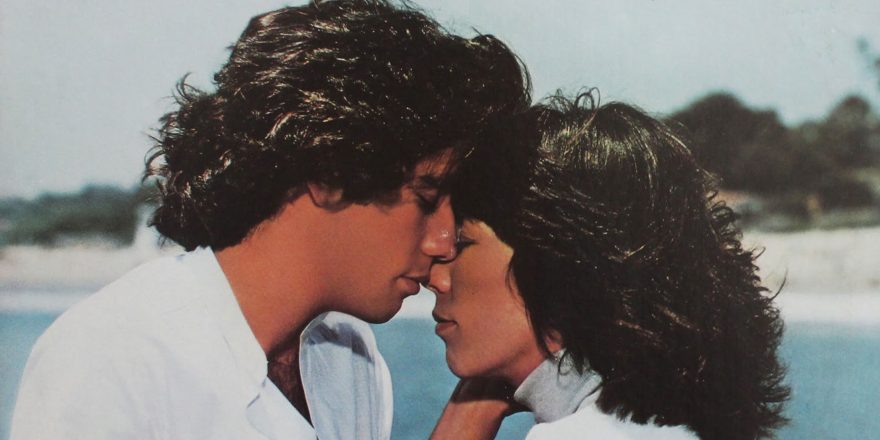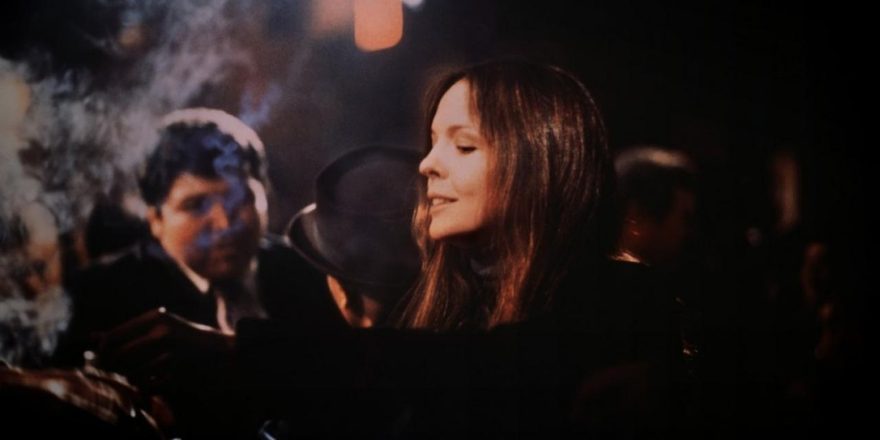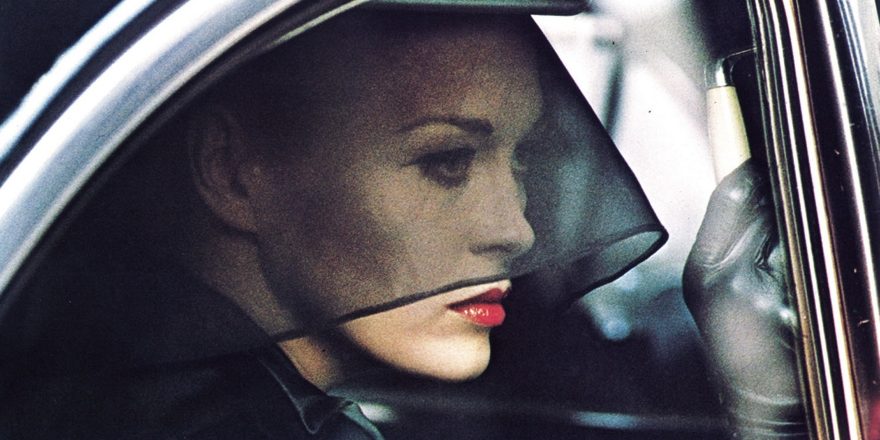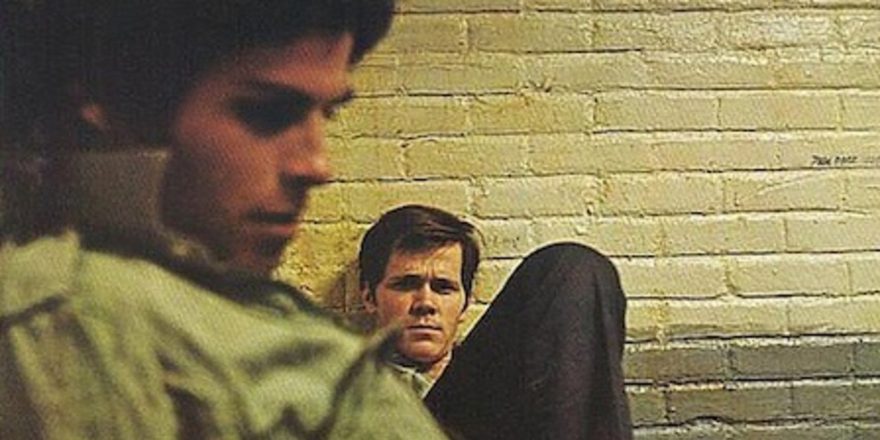In December 1978, there was a lot of anticipation for a new movie about to come out (if you’ll pardon the expression) starring Lily Tomlin and John Travolta. Tomlin had made a big splash with her sensitive, emotional performance in Nashville in 1975, for which she was nominated for a Best Supporting Actress Oscar, and with her co-starring role alongside Art Carney (who had recently won a Best Actor Oscar for Harry and Tonto) in Robert Benton’s The Late Show in 1977. Travolta was coming off the one-two punch of starring in Saturday Night Fever, in 1977, and Grease, earlier in 1978. (Both films were produced by Moment by Moment producer Robert Stigwood, who had hit the jackpot earlier in the seventies with blockbusters like Jesus Christ Superstar and Tommy.) The film was written and to be directed by Jane Wagner, Tomlin’s longtime creative collaborator, whom apparently everyone in the business knew was also her lesbian lover. (Tomlin didn’t officially come out of the closet until 2013, the same year she married Wagner.) Gay rumors about Travolta didn’t start to emerge until the late eighties, and although the speculation persists, he has never publicly acknowledged what appears to be a reasonable assumption in the industry. Allegedly. But if there was ever any foreshadowing about the issue, Moment by Moment is the film, in retrospect, that provides the most grist for the mill.
When Moment by Moment was finally released, it was a monumental bomb. Critics savaged the film for its rank sentimentality and its apparent inability to recognize its own campy excesses. One of the kinder critiques, from the Monthly Film Bulletin, framed it this way:
“Critics are fond of attributing a film’s badness to some hypothetical computer: this truly terrible movie might have been made by HAL in his most maudlin ‘Bicycle-built-for-two’ mood, as the plugs were being pulled out.”
Ouch. Although Tomlin bounced back two years later with the box-office hit 9 to 5, some would argue that Travolta’s career never fully recovered from this “fiasco,” tainting his meteoric rise as a macho sex symbol with a feminized role barely concealing a strong homosexual subtext. I saw the film in the theater as a precocious teenager when it came out and quite liked it, scoffing at the critics who hadn’t bothered to dig into the film’s meta-references and genre- and gender-bending. How could they be so basic?
In order to fully appreciate Moment by Moment, one has to understand three fundamental concepts of “queer” cinema that seem to be increasingly difficult for critics and audiences alike to grasp: camp, classical Hollywood female melodrama, and feminism. A close examination of the film reveals how deliberate, adept and self-conscious the film is in its utilization of all three.
The opening tracking shot of the credit sequence has Lily Tomlin, as Trish, wistfully striding along Rodeo Drive in her slinky white satin blouse and beige skirt as designer store signs – Gucci, Hermès, etc. – dissolve in and out, accompanied by seventies soft-rock saxophone music. (Faye Dunaway would appear in an almost identical credit sequence eight years later in the made-for-TV movie Beverly Hills Madam.) A dedicated semiotician might already be reeling at the sheer volume of signifiers on offer, as the film economically establishes itself as a female melodrama with camp overtones featuring a star who is from the outset obviously playing against her usual screen persona. When this long tracking shot cuts away to a tracking shot of John Travolta, as Strip, strutting his trademark strut (forever branded in our brains from the opening credit sequence of Saturday Night Fever) in his tight blue jeans and light denim shirt, the two-hander scenario is perfectly set up. Strip serendipitously follows Trish into Schwab’s Pharmacy (nowhere near Rodeo Drive, but who cares) and stands behind her as she utters to the pharmacist the infamous first line of the film: “What about the sleeping pills?” Any film that references a barbiturate or painkiller in its first line (think Elizabeth Taylor yelling “Injection!” at the outset of Boom!) is destined to be camp, and the fact that the couple meets at Schwab’s, the very hangout where many a young starlet was discovered by a lecherous producer back in the day, makes it clear that the story is going to be embedded in classic Hollywood tropes. The setup also immediately reverses the expected gender roles, with Travolta posited squarely as the ingénue. Trish can’t get her Seconals from the pharmacist without a prescription, so Strip helpfully shows up at her expensive Malibu oceanfront home with her “reds.” When Trish declines the offer, Strip says, “Wait a minute, Miss Ultrafrost, you’re the one who wanted the pills, not me.” (Later in the film he calls her “Miss Fabulash” – whether or not there was a secret promotional tie-in with a cosmetic company is an open question.)
Moment by Moment is one of those ultimate L.A. movies, the kind that perfectly captures what the industry town looks like from inside and out. As it turns out, Strip and Trish have crossed paths once before: he was a valet parking attendant at a fancy party who was accused of putting a dent in Trish’s ultra-cool baby blue Mercedes, and she defended his honor (another one of many gender roles reversals), confessing that she herself made the dent in a prior accident. The scene in which this most meager of plot set-ups is revealed, a narrative pretext worthy of a porn movie, tells you almost all you need to know about how Hollywood works. Adding to the veracity of the film, the cinematography, by veteran cinematographer Philip H. Lathrop (he shot They Shoot Horses, Don’t They?), with his soft lens, perfectly captures that specific, glimmering, smog-filtered sunlight that makes everyone in L.A. glitter and gleam like they’re in a shampoo commercial. Only Hal Ashby’s Shampoo, released three years earlier, and Paul Schrader’s American Gigolo, which followed two years later – like Moment by Moment, both films about sexually objectified studs who bed older women (“Isn’t that kind of faggoty?” Carrie Fisher memorably asks in Shampoo) – capture this desultory L.A. afternoon atmosphere with equal fidelity.
From the outset, Moment by Moment systematically sets up the conventions of female melodrama, and introduces the theme of “twinning” that underscores the film’s reversal of sex roles and the homosexual subtext. Although Trish is the one who is brooding over a messy divorce, it’s Strip who is consistently presented as the “damsel in distress” – immediately indicated by her defense of his honor, and as she fusses over him when he coughs like an Emily Brontë heroine, prompting her to bring him a hot drink. Tomlin’s acting on the phone when she talks to her soon-to-be ex-husband is borderline over-the-top, and straight out of the female melodrama handbook, as she painfully tries to conceal her emotions; a subsequent scene when she talks on the phone with her best friend, Naomi, who is at the waxing salon, reinforces the genre reference. Trish and Strip are set up as mirror images of each other throughout, starting with their physical appearance – both having similarly slim builds and almost identical brunette hairstyles – and continuing with a series of parallels, the opening mirrored tracking shots of the characters walking, both having cars with dents in them, both fussing over their little dogs, etc. It’s not too much of stretch to suggest that the twinning implies a lesbian relationship, with Travolta in the femme role! Just as Who’s Afraid of Virginia Woolf? may have suggested a homosexual scenario transposed onto heterosexual characters, Moment by Moment can be construed as a lesbian romance, thinly disguised.
The plot reinforces the homosexual subtext when Strip protests to Trish that Greg, his “best friend,” is nothing more than that. “You’re not Greg’s partner, are you?” asks Trish. Although she means partner in crime – he’s a drug dealer – the double entendre is inescapable. “Look,” replies Strip, “we’re just best friends, and Greg is into the heavy-duty stuff, I’m not.” It’s not hard to imagine what the “heavy-duty stuff” might mean, and when Greg ends up released from jail on bail and subsequently murdered by the drug kingpin to make it look like an overdose, Strip retreats to his hotel room by himself to grieve, lying down on his bed, distraught, the only scene we are left alone with him. (The majority of the film is resolutely identified with Trish’s point of view.) As the feminized hustler, Strip is coded as a gay male (retroactively reinforced by Travolta’s later homosexual scandals), and refigured as the lesbian lover.
The most striking aspect of Moment by Moment is the way in which Strip is consistently treated as a sexual object and placed in the passive role. Strip shows up at Trish’s house in wet clothes (once again distraught and needy), presenting the first of many opportunities for him to shed them. (“Oh Strip,” says Trish memorably, his name becoming a command.) She tucks him into the divan with a fur blanket, and after she is shown watching My Man Godfrey on TV (a classic Hollywood film about a rich socialite, like Trish, who falls in love with a servant, like Strip, the parking valet, and later, grocery boy), we finally get to the first of several steamy sex scenes. (Kudos to a lesbian and – allegedly – a gay thespian for working up such admirable sexual chemistry!) Trish makes the first move, running her hand down Strip’s nude body until she holds his cock, concealed by the blanket. The sex scenes read almost like the softcore porn movies so popular in the seventies (Bilitis, The Story of O, etc.), but with the male character in the conventionally passive feminine role. After a number of scenes of Trish reading Architectural Digest on the beach as they play with their dogs, or eating the exotic salade niçoise that she introduces Strip to, we come to the infamous hot tub scene. Strip strips once again at Trish’s behest, close-ups of his body shown as if from her point of view, co-opting the male gaze. “Let’s smoke some pot,” says Trish eagerly, reinforcing her newfound, post-marriage hedonism. When Strip begins to become suspicious of her blatant sexual objectification of him, he asks her if she loves him. She can only reply, “Yes, I love you in bed.” He tells her he loves her, and accuses her of only using him for sex. These confrontational scenes are shot in pure melodramatic style, with an angular shadow worthy of a Joan Crawford picture veiling Trish’s face. “I’ve had it with cheap sex!” declares Strip, to which Trish replies plaintively, “I never had cheap sex before. I was kind of looking forward to it.” Lines in the film like this would tend to suggest a certain tongue-in-cheek feminist role reversal, although like all good camp, the scenes are played completely straight, without irony. The film also taps into a certain feminist zeitgeist of the era, when Jill Clayburgh ruled the screens with her persona of sexual independence and post-divorce, postfeminist liberation. (In An Unmarried Woman, also released in 1978, Clayburgh’s character famously says, “’Balls!’ said the Queen. ‘If I had ’em, I’d be King.’”) Looking for Mr. Goodbar, released a year earlier, also presented a female character, played by Diane Keaton, who was hedonistic and sexually aggressive, coded as having the sexuality of a liberated gay male, much like Tomlin’s faux-butch lesbian character here.
The camp aspect of the film is blatant, evinced by a number of tropes of the female melodrama that are shamelessly woven into the narrative. Strip provides Trish’s white Shih Tzu, Scamp, with a companion of his own, a stray mutt they name Corky. This Lady and the Tramp scenario, mirroring the class distinction between Trish and Strip, is made all the more interesting by the fact that both dogs are male! The couple spends its time on the beach making sandcastles, taking personal Polaroids of one another, and putting messages in bottles – all three tropes familiar to melodrama. This self-conscious campiness builds to a crescendo when Dan Hill’s “Sometimes When We Touch” comes on the radio, making it clear that Wagner, the writer/director, knows exactly what she’s doing.
Several scenes in the film directly or indirectly reference Douglas Sirk, the classical Hollywood director famous for his female melodramas. When Trish’s best friend Naomi finally pays her a visit, Strip comes home with a bag of groceries, and Trish, caught off guard, pretends he is the grocery delivery boy. Strip is humiliated, and runs away in disgust. The scene mines the same territory as the famous scene in Sirk’s Imitation of Life, in which Susan Kohner, the light-skinned black daughter of Lana Turner’s black maid (Juanita Moore), sarcastically pretends to be Turner’s servant, rather than her surrogate daughter. In a later scene, Trish and Naomi are concerned about what Trish’s son might think of her May-December romance with Strip, echoing the narrative of Sirk’s film All That Heaven Allows, in which Jane Wyman falls in love with a much younger man, played by Rock Hudson (interestingly, a gay actor playing straight), much to the horror of her two children. Issues based on class distinctions and the disruption of social taboos are the very stuff of female melodrama, something of which Wagner is very well aware. Moment by Moment is essentially a Sirkian melodrama in seventies vernacular.
Back to the plot, the film takes a digression into neo-noir territory (American Gigolo and Looking for Mr. Goodbar were also identified as a neo-noirs) when Naomi accompanies Trish on a montage of sleazy Hollywood Boulevard locations to search for the mortally offended Strip. “I’m right behind you, girl,” says the blond proto-feminist Naomi, cast in the arch sidekick Eve Arden role. Strip finally turns up back at the house to get his things and leave, but Trish convinces him that she had only panicked about their age difference. “Oh God,” she says, “I’m not ashamed of you. I’m just bothered by how much older I am than you. I couldn’t deal with it all of a sudden.” They make up, and decide to go public with their affair at the art opening of one of Trish’s friends, an exhibition of photographs of feet called Footography. (Of the show, Naomi has one of my favorite lines of the seventies, to wit: “We all have ideas. Sometimes the real talent is knowing when not to do anything with them.”) Strip is humiliated once again at the opening when everyone stares at them, and Trish confronts her husband, who is disgusted by her supposed exhibitionism. “How old is he?” he asks, aghast, to which she responds that he’s probably about the same age as the girl he’s involved with in an affair that broke up their marriage. When he says it’s worse for her, she replies, “Worse for me, a woman,” pointing out the double standard always applied to such scenarios. It’s textbook seventies feminism, turning the tables on men, and giving them a dose of their own medicine.
With Strip gone once again, the focus is entirely on Trish as she takes a melancholy walk on the beach. When she finds a message in a bottle from Strip (it reads, “What a world,” earlier identified as his primary philosophy of life), she decides to run after him one more time. A melodramatic driving sequence takes her to the trailer park where she knows Strip is holed up with Greg’s parents; she knew his threats to do porn in Vegas were empty! She presents him with a message in a bottle of her own – “Happy Birthday!” – and the lesbian couple is at last lovingly and permanently reunited, sealed by a kiss, and the device of a series of Polaroids of them together as the end credits roll, one Polaroid developing before our very eyes, like their relationship has done. It’s a brilliant trope with which to end the film, evoking the sentimental keepsakes of female melodrama, the ephemeral nature of love, and the memories that develop … moment by moment. As a closeted queer teenager, I, for one, was suitably moved.







